Most child injuries are preventable. There are some very important things you can do to keep your baby safe like using an infant car seat correctly every time in a vehicle, preventing your baby from falling off furniture or down stairs, and using a safe crib. Often injuries happen because parents aren’t aware of the risks to their baby’s safety.
Safe Sleep and S.I.D.S reduction
The safest sleeping position for your baby is on their back. Since recommending that babies sleep on their backs, rather than stomach or side, the rates of sudden infant death syndrome (SIDS) have dropped by 40% in Canada.
A baby that overheats is at an increased risk of SIDS, so it is recommended the room environment is kept at a comfortable temperature and no more than 21c. To reduce the risk of overheating and suffocation it is recommended that blankets and loose bedding are not used. The baby can be placed in the crib with a suitable layer of clothing and no blankets.
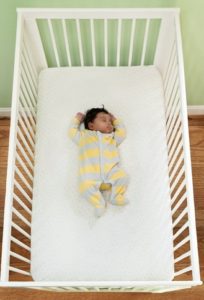
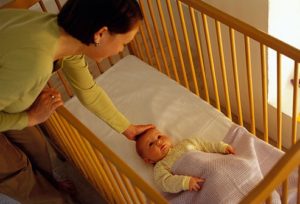
Features of a safe crib
Your baby’s crib or cradle should have:
- A firm, flat mattress that is in good condition and fits snugly into the crib or cradle. If you can fit two fingers between the mattress and the side of the crib, the mattress is too small.
- A mattress that is no more than 15 cm (6 inches) thick for a crib or no more than 3.8cm (1.5 inches) thick for a bassinet
- Mattress supports securely attached to the crib frame
- Slats (railings) that are no more than six cm (2 3/8 inches) apart
- A manufacturer’s sticker that states the crib or cradle was made after September 1986. Cribs or cradles made after that date meet Canadian Safety Standards. All cribs should be checked regularly for safety (especially secondhand cribs).
- Fixed and not drop sides
- A tight fitting bottom sheet
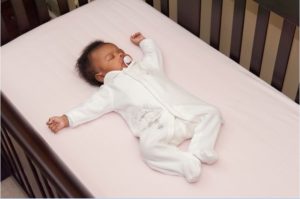
Bassinets are made for babies who are under three months old and weigh less than 10 kg (22 lbs.). The largest size for a bassinet is 50 cm (20 inches) wide and 90 cm (35 inches) long. The mattress should be firm and fit snugly. You should stop using the bassinet when your baby:
- Is over three months old, or;
- Is over 10 kg (22 lbs), or;
- Can roll over, push up on his or her hands and knees or sit up
Things to avoid
Your baby should NOT sleep with:
- Pillows
- Plastic mattress covers
- Comforters, quilts, heavy blankets or sheepskins
- Blankets or towels over their head
- Bumper pads
- Stuffed animals or toys
- Positioning devices, such as wedges or rolled up towels or blankets
- Baby bottles (they may cause choking and increase the risk of early childhood tooth decay)
Avoid places that are not designed for infant sleep. They can put your baby at risk for falls, suffocation, getting wedged between structures or having someone else roll onto them. Places not designed for baby’s sleep are:
- Air mattresses
- Sofas, armchairs, recliners and loose cushions
- Soft surfaces, such as a waterbed, bean bag chair, feather mattress or down comforter
- Adult beds
- Sibling’s beds
- Devices, sometimes called ‘sidecars’ (either manufactured or home-made), that attach to adult beds as an alternative place for baby to sleep
Cribs, cradles or bassinets should be away from long mobiles and blind and curtain cords (your baby may become tangled in the cords and be strangled)
To reduce the risk of SIDS keep your baby (asleep or awake) in a smoke-free environment. Smoking is a major risk factor for sudden infant death syndrome (SIDS). Make sure no one smokes around your baby – in your home, car or when you are out anywhere else with your baby.
Bed-sharing
When a baby shares a sleeping surface with another person, it is called bed-sharing. Having your baby’s crib in the room where you sleep is called room-sharing. Room-sharing helps protect your baby against sudden infant death syndrome (SIDS) and can make night-time feeding easier. Talk to your public health nurse for tips on room-sharing and breast/chestfeeding.
If you decide to bed share
Here are some important things to think about before you take your baby into bed with you:
- Your baby should be placed on their back to sleep
- The mattress should be firm and flat
- Make sure your baby cannot fall out of bed or get stuck between the mattress and the wall, the headboard or the footboard
- The room must not be too hot and your baby should not be overdressed
- Move comforters, blankets and pillows away from the baby
- Make sure your baby cannot wriggle into or under a pillow
- Your baby must not be left alone in or on the bed because even very young babies can wriggle into dangerous positions
- Your partner should know when your baby is in the bed
- Do not allow a pet or other child to sleep in your bed if you are bed-sharing with your baby
- Do not bed-share in the early months if your baby was born preterm, was small at birth or has a fever
You should never sleep with your baby in your bed if you (or any other person in the bed):
- Are a smoker, even if you never smoke in bed
- Are overtired to a point where you would find it hard to respond to your baby
- Have any illness or condition that affects your awareness of your baby
- Have taken any alcohol or drugs (over-the-counter, prescription, or street drugs), especially those that make you very sleepy or less able to respond
Car Safety Seats
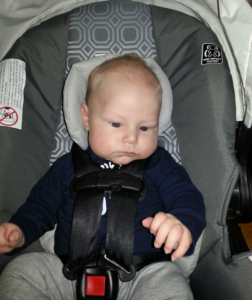
When used correctly, car safety seats save lives and reduce injuries. In Alberta, you are required by law to use an approved, car seat for your baby. A child is safest in a rear facing car seat until they are at least two years old or have reached the maximum weight or height limit for a rear facing seat (as stated by the manufacturer). Rear facing car seats that have a higher weight and height limit are preferred and will keep your child in a safer rear facing position beyond age two.
When buying a car seat, parents are often confused by the variety available. All car seats sold in Canada must have a Canada Motor Vehicle Safety Standards (CMVSS) and expiry date stickers. The best seat for you and your baby is the one that you will be able to install and use correctly with your vehicle. Buying a second-hand child safety seat is not recommended as it could have been damaged in a collision or have developed defects as it ages.
Check out Healthy Parents Healthy Children for information about buying and using infant safety seats.
Injury Prevention
Babies are at higher risk of injury because they:
- have thin, sensitive skin that burns easily
- learn and explore by placing things in their mouths
- can get into situations they can’t get out of
- have no sense of danger or risk
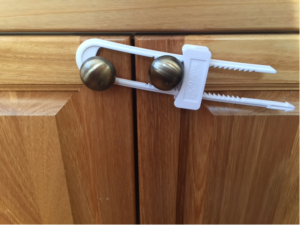
Burns
- NEVER carry your baby and hot liquids or foods at the same time. Your baby can get burned. Use a lid on hot drinks, even at home
- To protect your baby from tap water scalds, reduce the temperature of your hot water heater to between 48° and 54°C
- To protect your baby from house fires, be sure you have a working smoke alarm in your home. Test the batteries every month to be sure they work. We advise that you change the batteries once a year on your baby’s birthday
Choking
Infants’ airways are small and easily blocked, placing them at higher risk of choking. If an object is small, round and compressible it can be a choking hazard. By 9 months of age, a baby’s natural tendency to put objects in their mouth becomes a major risk for choking.
- Use age appropriate toys
- Check all toys on a regular basis for breakage or cracking
- Keep all toys out of the crib
Suffocation
- Always use an approved crib, cradle or bassinet for sleep
- Follow the recommendations for safe sleep
- Never leave a child unattended in strollers, baby seats, car seats or high chairs
Preventing Falls
Babies are at risk of falls as they can wiggle, push off, kick and roll when they are very young. Their head is large compared to the rest of their body and they are more likely to land on their head in a fall.
- It is important to always keep one hand on your baby, even when using safety straps.
- Never leave a baby alone on an elevated surface even for a moment.
- Using a changing mat on the floor is safer than on a raised surface
- Never put car seats, bassinets, bouncy chairs, and baby seating devices on chairs, tables or couches. The floor is the safest option.
- Always use the safety straps on carseats, strollers, high chairs, bouncy chairs etc. Three or 5 point harnesses are the safest.
- Once baby starts to move install gates at the top and bottom of stairs
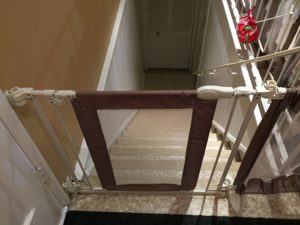
For more information about injury prevention for your family visit:
Alberta Health Services – Injury Prevention and here for more safety information for babies and children.
Use of Soothers (Pacifiers)
Soothers are not recommended while breast/chestfeeding is being established. Using soothers during this time can lead to less breast/chest suckling and reduce your milk supply. Also, some babies who suck on soothers have more difficulty learning to breast/chestfeed.
If you choose to give your baby a soother, here are some safety tips:
- Choose a soother that is the correct size for baby’s age.
- Choose a soother that has a soft, flexible nipple.
- Make sure the nipple and base of the soother cannot come apart.
- Check the soother regularly. Replace the soother every 2 months.
- Keep soothers very clean. After each use, wash it with hot soapy water and then rinse it.
- Avoid cleaning the baby’s soother in your own mouth.
- Never coat the soother with honey, sugar, or other foods or sweeteners.
Soothers should not be attached to strings that could get wrapped around baby’s fingers or neck.
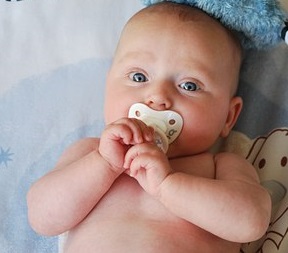
Finger, thumb or pacifier sucking, often called non-nutritive sucking, is normal behavior in infants and young children. Non-nutritive sucking may begin early in life and decrease as the child gets older. There is no clear evidence of the best time to stop these habits. If using a pacifier or thumb/finger sucking seems to interfere with speech, social skills or tooth alignment speak to your healthcare provider for advice.
Pet Safety
Welcoming a new baby is exciting for your family. If you have a dog , before you bring your baby home for the first time, send something from the hospital with the baby’s scent (such as a blanket) for them to investigate.
When you return from the hospital, your dog may be eager to greet you and receive your attention. Have someone else take the baby into another room while you give your dog a warm, but calm welcome. Keep some treats handy so you can distract them. After your initial greeting, you can bring your dog with you to sit next to the baby; reward them for good behaviour. You want your dog to associate being with the baby as a positive experience. To prevent anxiety or injury, never force your dog to be near the baby, and always supervise any interaction.
Supervision is important with any type of pet when interacting with the baby. If you know you will need to keep your cat or dog out of certain areas of your home after the baby arrives (for example your bedroom), it is a good idea to introduce this change well before baby arrives.
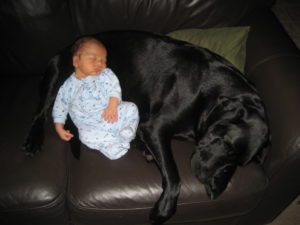
New puppies and kittens often carry harmful germs. Be sure their immunizations are up to date. Snakes and other reptiles often carry bacteria (e.g. salmonella) that can easily infect babies. Make sure to wash your hands carefully after interaction with all pets.
Life will be busy caring for your new baby, but try to maintain regular routines as much as possible to help your pet adjust. And be sure to spend one-on-one quality time with your pet each day – it may help relax you too.
With proper training, supervision, and adjustments, you, your new baby and your pet should be able to live together safely and happily as one (now larger) family.